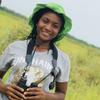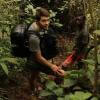Human-wildlife conflict and coexistence is a shockingly common problem, often with enormous consequences for both individual animals and entire populations.
When human-wildlife conflict comes to mind, you may immediately think of wildlife crime instead - which isn't wrong, since many regions with wildlife crime problems like poaching are also areas where people may frequently deal with human-wildlife conflict, causing the two issues to go hand-in-hand. But human-wildlife conflict is a much broader issue encompassing many ways that human presence and interference can cause problems for us and animals alike. Human-wildlife conflict includes:
- Elephants trampling a farmer's crops, resulting in retaliation
- New real estate developments infringing on ecosystems where predator species live, leading to predators having less territory and less food, which in turn leads to predators attacking domestic animals and livestock
- Freeways dividing the territory of animals like mountain lions, leading to wildlife venturing into neighborhoods or being killed by cars
- Lead bullets used in hunting causing scavengers like condors to die of lead poisoning
These are just a few examples of how humans can negatively impact wildlife, and it's clear to see how many of these scenarios could escalate. Human-wildlife conflict solutions don't just include ways in which we can prevent these issues (for example, through tracking predators, monitoring populations' territories, or building barriers and wildlife crossings monitored by sensors), but also the ways in which we can help people connect with wildlife and care about learning to live alongside them.
If you're interested in solutions that can prevent human-wildlife conflict, join this group and get to know the people who are working to protect and save species around the world!
Header image: Casey Allen on Unsplash
No showcases have been added to this group yet.
- @Rob_Appleby
- | He/him
Wild Spy
Whilst I love everything about WILDLABS and the conservation tech community I am mostly here for the badges!!





- 1 Resources
- 315 Discussions
- 11 Groups
- @Phil_HWS
- | Virtual Fencing
Innovations with Wildlife Fencing to mitigate Human Wildlife Conflict
- 0 Resources
- 4 Discussions
- 2 Groups
Royal Society for the Protection of Birds (RSPB)
- 0 Resources
- 0 Discussions
- 5 Groups
- @mimi_rezoana
- | She/her
I am Arefine from Bangladesh. I am a graduate student. I am a snake educator and young herpetologist. I founded Kundali Foundation for snake related work.
- 0 Resources
- 0 Discussions
- 9 Groups
- @a.zubiria
- | she/her
- 0 Resources
- 3 Discussions
- 11 Groups

- 0 Resources
- 0 Discussions
- 15 Groups
- @MorenaRodriguez
- | She/Her
- 0 Resources
- 1 Discussions
- 4 Groups
- @muganyizi
- | Mr.
Muganyizi Melchior Kamuganga is a Tanzanian youth passionate about creating positive social changes. He is a professional Wildlife manager and passionate beekeeper. He is a member of the Lightup impact community in east Africa, Masterpeace global network, Metis and Ashoka alumni
- 0 Resources
- 8 Discussions
- 8 Groups
conservation biologist working primarily in Argentina
- 0 Resources
- 1 Discussions
- 4 Groups
- @Yitmwa
- | She/Her
A conservation biologist with specialization in wildlife monitoring and community engagement. With experience in deploying camera traps and bioacoustics for mammal and birds monitoring in the Afrotropical environment.
- 0 Resources
- 1 Discussions
- 5 Groups
- @RobMCook
- | He
Ecologist specialising in human-wildlife conflict research. PhD in elephant ecology.

- 0 Resources
- 2 Discussions
- 4 Groups
- @Durgananda
- | He
- 0 Resources
- 0 Discussions
- 19 Groups
A recent online video of a baby bear's efforts to scale a steep cliff took what seemed like an inspirational moment viral. But after the initial enthusiasm for the video came some controversy when scientists pointed out...
22 November 2018
In this case study, Katarzyna Nowak writes about her work with the Southern Tanzania Elephant Project (STEP) trialing beehive fences as human-elephant conflict mitigation tools. Earlier this year the research team...
27 August 2018
The understanding of the interplay of movement, behaviour and physiology that biologging offers has applied relevance for a range of fields, including evolutionary ecology, wildlife conservation and behavioural ecology...
30 July 2018
The winners of our Human Wildlife Conflict Tech Challenge are offering regular updates throughout the year to chronicle their failures, successes and what they learn along the way as they develop their solutions. In...
27 July 2018
As people continue to move into natural habitats, conflicts between human beings and wildlife continue to rise. Although there are a number of early-detection systems and tools in place to prevent human-wildlife...
5 June 2018
Conflict between humans and wildlife is increasing as human communities expand and wild habitats are destroyed, prompting need for new mitigation techniques. As a winner of the Human Wildlife Conflict Tech Challenge,...
19 April 2018
‘The Field’… Say the words ‘The Field’ to a group of conservationists and it will immediately conjure up vivid memories of everything from sticky wet rainforests to burning dusty deserts. What’s more, it’s almost...
17 January 2018
Article
A new research project is looking to investigate whether technology combined with the ancient skills and knowledge of Namibian trackers can help save cheetahs from extinction. Called FIT Cheetahs, the research project...
4 December 2017
We are delighted to announce that British conservation technologist Alasdair Davies and the Dutch team of Laurens de Groot and Tim van Dam from the ShadowView Foundation are the winners of the first international Human...
1 November 2017
Our panel of international experts has been hard at work reviewing the 47 proposals we recieved for innovative technological tools to address human wildlife conflict. The panelists have systematically been assessing the...
20 October 2017
The inherent complexity of not only deploying technologies in the field but also doing so in a scientifically rigorous manner can prove a substantial barrier for the effective use of conservation technologies, and clear...
11 October 2017
The Domain Awareness System (DAS) is a revolution in monitoring technology, creating real-time awareness of protected areas assets. This technology has the potential to completely change standard monitoring procedures...
26 September 2017
October 2025
event
October 2024
September 2024
event
32 Products
3 R&D Projects
42 Organisations
Recently updated products
Recently updated R&D Projects
Recently updated organisations
| Description | Activity | Replies | Groups | Updated |
|---|---|---|---|---|
| HWC Tech Challenge Update WInners to be announced on the 1st November, 2017 First of all, we’d like to thank you all again for your interest and participation in the... |
|
Human-Wildlife Coexistence | 7 years 9 months ago | |
| Hello, this device looks really interesting...has anyone tryed? what brand is it? how much does it cost? what's the range of the speakers? what kind of sound does it makes? I... |
|
Human-Wildlife Coexistence | 7 years 10 months ago | |
| Hi Mark and Teun, we have been investigating this technology also. It is already being used, but has two problems. First, their reach is often very limited (around 50m) and the... |
+13
|
Human-Wildlife Coexistence | 7 years 11 months ago | |
| Dear Somak, Thank you very much for writing and we are sorry information on the challenge did not reach you in time. We are certainly interested in furthering discussions... |
+14
|
Human-Wildlife Coexistence | 7 years 11 months ago | |
| Hi Gwen, That's a tough question Gwen! And for any destination in the Arctic counts: it is horribly expensive! I suggest you count on Iqaluit in Nunavut-Canada. Access is... |
+12
|
Human-Wildlife Coexistence | 7 years 11 months ago | |
| Thank you, Gert. My proposed solution takes security into account heavily. Excited to share it with you and the panel as well. Claire |
+7
|
Human-Wildlife Coexistence | 7 years 11 months ago | |
| Additional information on human-polar bear conflicts can be found in this article |
|
Human-Wildlife Coexistence | 8 years ago | |
| Friends and fellow researchers in the WILDLABS community I would like to hear your valuable opinions on the doctoral research project I am... |
|
Human-Wildlife Coexistence, Funding and Finance | 8 years ago | |
| For those interested: in the acoustics channel I have posted news on our sound event recognition sensor, using conv-net: https://... |
|
Human-Wildlife Coexistence | 8 years 3 months ago | |
| Hello all! There's going to be a workshop led by Human Wildlife Conflict Collaboration on the fundamentals of HWC. It will... |
|
Human-Wildlife Coexistence | 8 years 3 months ago | |
| Peter, thanks for your reply and sorry for the dealyed repsonse, I have been ahving some issues getting alerts in my email. I would like to talk to you more about your... |
|
Human-Wildlife Coexistence | 8 years 4 months ago | |
| Hi Udayan, Many thanks for following up and it's great to hear that it's an area of interest for you as well. I'm certainly interested to hear more about the work... |
|
Human-Wildlife Coexistence | 8 years 7 months ago |
Helping humans and tigers to co-exist in India
30 November 2020 7:08pm
Predator Deterrent - Human Effigy Based
3 October 2020 2:15am
Audio play back device when elephant crop raids
7 November 2019 7:55am
27 September 2020 1:57am
Suraci et al. have published a few papers about the use of an automated behavioral response system for sound playback when triggered by a camera trap. Their methods (see supplementary materials) are entirely open source and I even commissioned an engineer to make a few for me. The only issue is that the MP3 players need a separate battery pack to keep them charged or need to be charged weekly, as the sound runs continuosly since there would otherwise be a delay between the camera trigger and the MP3 player being turned on. This could probably be fiddled with to suit your needs, if the previous options don't work out.
https://besjournals.onlinelibrary.wiley.com/doi/10.1111/2041-210X.12711
27 September 2020 3:31am
We actually designed Boombox, the audio player shown above, based on the ABRS system by the Suraci paper and with Dr. Meredith Palmer. We made some optimizations on it since the paper advocates an approach to infer when the camera was triggered. We reverse engineered our camera traps and took the actual trigger signal from the trailcam PIR motion sensor. Later, we were contacted by one of the authors of the paper and he mentioned they had come to the same conclusion.
We built the MP3 playback system using a discrete MP3 decoder IC which allowed us more control over playback, power management, and we could pick out the output amplifier to drive the speakers. We knew we would need to put the system to sleep and immediately play sounds on wakeup which most players aren't suited to do.
We also made it so that it's solar rechargeable with lithium-ion batteries so that it could last in the field as long as possible. Unfortunately we couldn't use that feature because there's no point in outlasting the trailcams. But for this application, it seems we might be able to use the solar recharging functionality.
We've volunteered for a possible TechTutors season 2 workshop on open source MP3 playback and recording with Arduino. We're waiting to discuss it with Steph and Ellie. If this sounds interesting, please let us know.
Challenge: ElephantEdge
11 August 2020 12:00am
Did you know that Wildtrack's Footprint Identification Technique (FIT) can be used to promote human-wildlife coexistence!
3 June 2020 6:47pm
18 June 2020 4:38am
Hi Santhosh, welcome to the FIT community, we're glad you joined!
Karin has explained very nicely the difference between the footprint identification technique (FIT) that we use and the old 'pugmark' technique. I'd say that every technique, FIT included, has strengths and weaknesses. FIT, for example, will not work in an area where footprints can't be found. The pugmark technique was very reliant on expert assessment and was prone to inaccuracies for that reason, but on the plus side it could be rolled out over a huge area and engaged the traditional ecological knowledge that is part of India's cultural heritage. The camera traps that replaced it have had their fair share of problems (difficulties arranging the traps for optimal sampling, cameras being stolen, cameras are expensive etc). Our belief is that using several different non-invasive techniques for any one survey yields the most reliable results. I hope this helps.
18 June 2020 9:17pm
Thank you Karin for these details, I didnt read the latest papers, before writing my comment. Interesting to know about morphometrics usage (along with image processing).
18 June 2020 9:21pm
Thank you for these details.
I was about to ask the issues with different substrates. Now I understand the limitations and possibilities.
Yeah, I agree that each of these techniques have their own limitations. Thank you, these inputs definitely help.
Grassroots Innovations for Wildlife Conservation
19 May 2020 12:00am
Get To Know FIT
6 May 2020 12:00am
Era of the Condor: A Species' Future in Recovery
5 May 2020 12:00am
Locally-Brewed Conservation Technology from a Small Town in North Bengal
10 April 2020 12:00am
Technology Showroom of Artificial Intelligence (AI) aided Elephant Early Warning Systems
6 March 2020 6:09pm
19 March 2020 9:15am
Hi @Tim+Vedanayagam
Thank you for posting this. I'd be happy to contribute to the thermal sensing work under way. Can you confirm - have you built a thermal AI model and trained / labelled data for a particular camera?
We have been training a model for low cost (Lepton 3.5) thermal cameras via a challenge with WWF / Wildlabs and have 30,000 labelled images as our training dataset of Asian elephants. We're focusing on Deeplabel and YOLO with a plan to port to Tensorflow and it will be open source, so applicable for others to use and adopt in their early warning systems that use thermal.
More info here - https://www.zsl.org/blogs/conservation/zsl-whipsnade-zoo-becomes-a-space-for-high-tech-wild-elephant-conservation
Kind regards,
Alasdair
Webinar: IIED Community-Based Approaches to Tackling Poaching and Illegal Wildlife Trade
 IIED
IIED
17 March 2020 12:00am
Testing an Early Warning System to Mitigate Human-Wildlife Conflict on the Bhutan-India Border
11 March 2020 12:00am
3 Ways Your Conservation Technology Could Become a Shiny Pile of Junk, and How to Avoid It
9 March 2020 12:00am
#Tech4Wildlife 2020 Photo Challenge In Review
4 March 2020 12:00am
Accepting Applications: ArcGIS Solutions for Protected Area Management
4 March 2020 12:00am
Call for Nominations: Tusk Conservation Awards
3 March 2020 12:00am
Fence-Based Elephant Early Warning System
25 February 2020 12:00am
HWC Tech Challenge Update: Thermal Elephant Alert System
17 February 2020 12:00am
A New Cloud Platform Unveils the Most Diverse Camera Trap Database in the World
17 December 2019 12:00am
Mitigate Elephant-Human Conflict with ADSMO
[ARCHIVED] Upcoming Event: International Conference on Human-Wildlife Conflict and Coexistence
4 November 2019 10:54am
AI powered mobile app to save snakes
4 October 2019 7:10am
9 October 2019 8:45pm
Hi Nilaksha,
Interesting idea. My ideas are usually not that helpful, but I thought I would chime in with the following:
(1) Start small and local, this will help reduce the size of the training data set you will need. So if you can work with a specific set of communities in a particular area that has a known set of snake species, both venemous and non-venemous, you only need images for those species and you won't need as many.
(2) iNaturalist has a pretty decent database (not thousands, but hundreds) of identified images. I have no idea what the restrictions would be around getting access to the database, but this is a Citizen Science organization, so I don't THINK it should be too complicated, especially if your initial scope is limited.
(3) Venemous snakes need "love" too. PLEASE make sure the app does not encourage the locals to kill the venemous snakes unless absolutely necessary. While it is admirable to prevent the accidental killing of a non-venemous snake, you shoudl not be encouraging the purposeful killing of the venemous snakes, but should be encouraging people to stay clear if the snake is in the wild and get professional assistance if the snake somewhere that could be dangerous to humans or other animals.
(4) Look into organizations like the Rainforest Aliance, OpenAI, etc., which are non-profits doing work in or with AI, they might be able to help give you a leg up.
(5) If you start local, you could build into the app the contact information for the professionals to come in and deal with the dangerous snakes.
Hopefully some of this is useful.
Good luck,
Drue
10 October 2019 1:57pm
Thanks Drue for your valuable input.
This is certainly not to encourage killing venomouse snakes. We can actually incorporate the featurs you pointed out to save venomouse snakes as well. Ideally we can let the user know how to deal with a venomouse snake and whome to contact if he/she needs professional assistance.
Thanks again.
Nilaksha
Trade of body parts
23 August 2019 12:16am
Tech In the Wild: Where technology meets conservation
 Fauna & Flora
Fauna & Flora
22 August 2019 12:00am
Conservation and Technology Conference
 Bat Conservation Trust
Bat Conservation Trust
29 July 2019 12:00am
New technology trialled to better monitor human-gorilla conflict in Uganda
23 July 2019 12:00am
Makerspaces to empower communities to develop/refine their own solutions to HEC
27 May 2019 8:27am
28 May 2019 11:37pm
3 June 2019 3:31pm
Hi Aditya,
If you haven't already found it, you should check out our last virtual meetup, it was all about tools and spaces for collaboration and we featured a number of members who have set up and are working on conservation focused makerspaces. You can watch in and connect to the members featured here.
Steph
Caught in the crossfire – Tapirs in tiger territory
31 May 2019 12:00am
Technology lab focused on wildlife protection opens on Ol Pejeta Conservancy
31 May 2019 12:00am
HWC Tech Challenge: Smart Parks field update
25 March 2019 12:00am





















































23 September 2020 7:27am
I've worked on a similar project to try to scare lions away from bomas in Kenya that's pretty much a bunch of stuff from Adafruit rigged together with cheap marine speakers in an overly complicated custom case (picture is of previous generation, new generation in development). We also run LEDs to show various light displays. I imagine you could imitate a muzzle flash to deepen the illusion of gunfire. I'm also happy to discuss things (although I don't think I can match the technical expertise of Freaklabs).